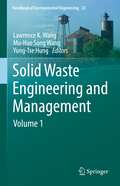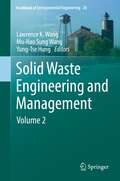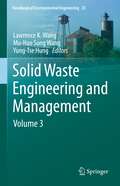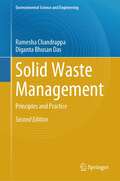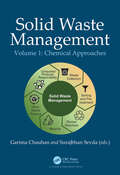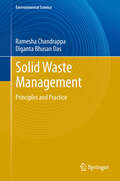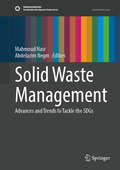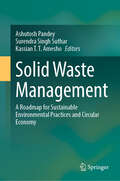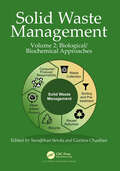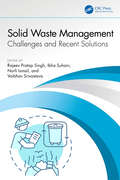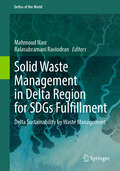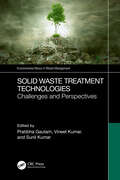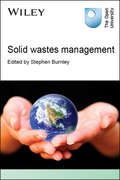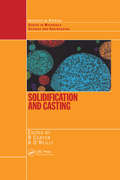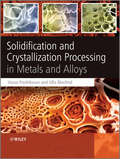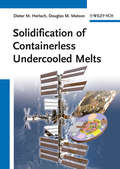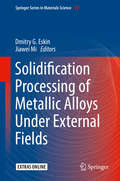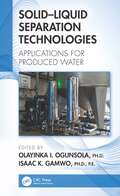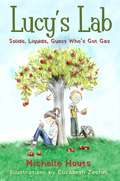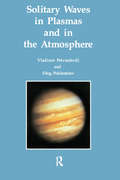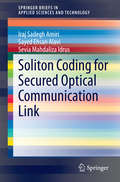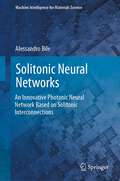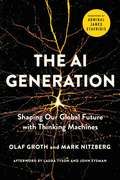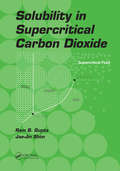- Table View
- List View
Solid Waste Engineering and Management: Volume 1 (Handbook of Environmental Engineering #23)
by Lawrence K. Wang Yung-Tse Hung Mu-Hao Sung WangThis book is the first volume in a three-volume set on Solid Waste Engineering and Management. It provides an introduction to the topic, and focuses on legislation, transportation, transfer station, characterization, mechanical volume reduction, measurement, combustion, incineration, composting, landfilling, and systems planning as it pertains to solid waste management. The three volumes comprehensively discuss various contemporary issues associated with solid waste pollution management, impacts on the environment and vulnerable human populations, and solutions to these problems.
Solid Waste Engineering and Management: Volume 2 (Handbook of Environmental Engineering #24)
by Lawrence K. Wang Yung-Tse Hung Mu-Hao Sung WangThis book is the second volume in a three-volume set on Solid Waste Engineering and Management. It focuses on sustainability, single waste stream processing, material recovery, plastic waste, marine litter, sludge disposal, restaurant waste recycling, sanitary landfills, landfill leachate collection, and landfill aftercare as it pertains to solid waste management. The volumes comprehensively discuss various contemporary issues associated with solid waste pollution management, impacts on the environment and vulnerable human populations, and solutions to these problems.
Solid Waste Engineering and Management: Volume 3 (Handbook of Environmental Engineering #25)
by Lawrence K. Wang Mu-Hao Sung Wang Yung-Tse HungThis book is the third volume in a three-volume set on Solid Waste Engineering and Management. It focuses on tourism industry waste, rubber tire recycling, electrical and electronic wastes, health-care waste, landfill leachate, bioreactor landfill, energy recovery, innovative composting, biodrying, and health and safety considerations pertaining to solid waste management.. The volumes comprehensively discuss various contemporary issues associated with solid waste pollution management, impacts on theenvironmental and vulnerable human populations, and solutions to these problems.
Solid Waste Management: Principles and Practice (Environmental Science and Engineering)
by Ramesha Chandrappa Diganta Bhusan DasThis book discusses solid waste management issues from global to local level. It offers an overview of the methods and paradigms of this burgeoning field, ranging from generation, characteristics, quantity, and practical challenges. The book discusses the major issues with respect to environmental health and economy, which are related to solid waste management. Furthermore, it contains updated information on topics such as toxicology, climate change, population pressure, urbanization, energy production, building and community design, and disaster preparedness in the context of solid waste management.
Solid Waste Management: Chemical Approaches, Volume 1
by Garima Chauhan Surajbhan Sevda‘Waste’ is generally identified as goods or material that are perceived to be mostly valueless. However, objects that are perceived to be waste based on consumers’ object valuation can be redefined to create value. This requires a multitude of efforts using different strategies in waste prevention and management. This book is an edited collection of various chemical approaches used for valorization of solid wastes, particularly, waste electrical and electronic equipment, plastic waste, and agro-residue waste, that provide research insights into the concept "waste-to-energy". Covering a variety of interdisciplinary topics on waste treatment and resource recovery makes the book one for all that serves as an excellent reading material for engineers, science scholars, entrepreneurs, and organizations who are working in the field of waste management.
Solid Waste Management
by Diganta Bhusan Das Ramesha ChandrappaSolid waste was already a problem long before water and air pollution issues attracted public attention. Historically the problem associated with solid waste can be dated back to prehistoric days. Due to the invention of new products, technologies and services the quantity and quality of the waste have changed over the years. Waste characteristics not only depend on income, culture and geography but also on a society's economy and, situations like disasters that affect that economy. There was tremendous industrial activity in Europe during the industrial revolution. The twentieth century is recognized as the American Century and the twenty-first century is recognized as the Asian Century in which everyone wants to earn 'as much as possible'. After Asia the currently developing Africa could next take the center stage. With transitions in their economies many countries have also witnessed an explosion of waste quantities. Solid waste problems and approaches to tackling them vary from country to country. For example, while efforts are made to collect and dispose hospital waste through separate mechanisms in India it is burnt together with municipal solid waste in Sweden. While trans-boundary movement of waste has been addressed in numerous international agreements, it still reaches developing countries in many forms. While thousands of people depend on waste for their livelihood throughout the world, many others face problems due to poor waste management. In this context solid waste has not remained an issue to be tackled by the local urban bodies alone. It has become a subject of importance for engineers as well as doctors, psychologist, economists, and climate scientists and any others. There are huge changes in waste management in different parts of the world at different times in history. To address these issues, an effort has been made by the authors to combine their experience and bring together a new text book on the theory and practice of the subject covering the important relevant literature at the same time.
Solid Waste Management: Advances and Trends to Tackle the SDGs (Sustainable Development Goals Series)
by Abdelazim Negm Mahmoud NasrThis book covers the latest advances in sustainable waste management and focuses on its implementation to mitigate water and air pollution, recycle and reuse raw material, and refine valuable metals. In this book, readers will learn about organic waste treatment, emerging waste management techniques, and the transformation of waste into value-added products. Particular attention is given to environmental sustainability and how we can better achieve it through innovative and responsible waste management practices. Divided into 10 chapters, the book outlines a wide range of topics such as the sustainable management of food wastes through cavitation-assisted conversion, rapid bioconversion of animal meat waste into compost using black soldier fly larvae, thermoluminescence properties of combustion-synthesized nanomaterials and their applications for achieving Sustainable Development Goals, and the creative reuse of plastic waste with a case study by Ghanaian artists. Expert contributors uncover new methods and approaches to waste management that invite readers to think critically about the current practices and their impact on the environment. In addition to these discussions, the work explores the challenges of environmental health in waste management for peri-urban areas. This book provides a unique blend of theoretical perspectives and practical case studies that will enrich the understanding of sustainable waste management, and it equips readers with the knowledge needed to contribute to a more sustainable future. The book is an invaluable resource for researchers in the field of environmental science, students at all levels studying sustainability and waste management, and practitioners working in industry.
Solid Waste Management: A Roadmap for Sustainable Environmental Practices and Circular Economy
by Ashutosh Pandey Surendra Singh Suthar Kassian T. T. AmeshoSolid waste management has become a significant global concern, particularly in maintaining and preserving value in solid waste resources. Local socio-economic disparities create various demands for sustainable solid waste management, leading to a wide range of waste reduction, recovery, and recycling solutions. This highlights the importance of accurately interpreting new policies within the framework of the circular economy. Accordingly, the title of this book is Solid Waste Management: Sustainable Environmental Practices and the Circular Economy. This book contains chapters on contemporary research that focuses on innovative technologies, concepts, models, and tools for sustainable solid waste management, as sustainable environmental practices and the circular economy have garnered increasing interest. This volume seeks to enhance scientific potential in the field of sustainable waste management by publishing cutting-edge theoretical and experimental studies that will advance our understanding of green technologies for sustainable solid waste management systems, aligned with the principles of sustainable environmental practices and the circular economy.
Solid Waste Management: Volume 2: Biological/Biochemical Approaches
by Surajbhan Sevda Garima ChauhanWaste materials in the solid form tend to be bulky and difficult to handle and transport. Its management could happen through physical, thermal, chemical or biological processing stages, with the exact sequence of and their operational optima being decided by the waste composition. In recent years, energy crisis and increased waste production have been undoubtedly major issues of concern. As we mentioned in the previous volume of this book, defining waste is crucial in terms of identifying the most adequate approach to recycle or recover resources from the waste. Various chemical, biochemical, and biological approaches are being investigated widely by researchers for waste valorization. Volume 2 of this book brings together the leading researchers working on solid waste management using biological and biochemical approaches.
Solid Waste Management: Challenges and Recent Solutions
by Rajeev Pratap Singh Ibha Suhani Norli Ismail Vaibhav SrivastavaThis book provides a holistic picture of waste and its management techniques, with all the recent advancements and necessary projections for the future, which aim to maximize the value-added products for environmental sustainability on a cost-effective basis. It emphasizes the practices, problems, and management of a broad variety of industrial solid waste and facilitates a major understanding of the utilization of sustainable tools to combat all types of problems.The book: Provides a holistic approach toward the topic to channelize waste management globally. Discusses waste minimization and regulation in conjunction with other integrated solutions and equipment. Reviews updated information and data for use to modify the system for advanced waste management. Explores innovative methods for defining, sorting, and treating solid waste. Includes case studies in each chapter for analyzing the concepts explored in the real world. This book is aimed at graduate students and researchers in civil and environmental engineering, and waste management.
Solid Waste Management in Delta Region for SDGs Fulfillment: Delta Sustainability by Waste Management (Deltas of the World)
by Balasubramani Ravindran Mahmoud Nasr“This book offers a comprehensive exploration of sustainable solid waste management practices in delta regions worldwide. With attention to detail, this work presents a systematic review, illuminating case studies, original research, and insightful meta-analyses tailored to address the unique challenges faced by delta environments. Home to over half a billion people, or approximately 7% of the global population, delta regions are dynamic ecological and social landscapes, despite accounting for only 1% of the world's land area. Yet, they play a pivotal role in national economies. Given the significant size and density of populations in these regions, understanding solid waste generation patterns, trends, and impacts is essential for global sustainability efforts. By focusing on deltaic regions, we aim to provide essential insights into effective policy planning and advancements in social and ecological sustainability. Explore a diverse array of topics, including the bioconversion of food waste into environmentally friendly compounds, sustainable production and disposal practices to address water quality concerns, and innovative waste management applications to combat channel clogging and flooding in delta districts. Delve into best practices for managing climate-related flood risks, addressing urban responses, and tackling environmental pollution associated with unmanaged waste disposal in delta catchments. Additionally, gain valuable insights into the regulatory framework guiding waste management practices, particularly in delta regions facing significant plastic pollution challenges. This book navigates the complexities of solid waste management in delta regions, paving the way for a more sustainable future.”
Solid Waste Treatment Technologies: Challenges and Perspectives (Environmental Nexus in Waste Management)
by Pratibha Gautam Vineet Kumar Sunil KumarSustainable waste management is a major step towards the attainment of Sustainable Development Goals. This book covers all technical, managerial, and legislative aspects of waste management at a global scale, providing a detailed description about different types of wastes, their characteristics, legal perspectives, and sustainable practices for their management. It explains developments in waste treatment technologies (classified based on waste type) and understanding the fundamentals of circular economy in waste management, supported by various case studies.Features: Discusses fundamentals of solid waste management for sustainable waste management practices Describes technological aspects of waste management covering various physicochemical, biochemical, and thermochemical processes Summarizes regulatory framework for waste management at the global level Highlights the scope for circular economy in managing solid wastes Includes dedicated chapters on case studies imperative for capacity building in waste management This book is aimed at researchers, graduate students, and professionals in environmental engineering, and waste management.
Solid Wastes Management
by Stephen BurnleySolid Wastes Management begins with a focus on processing municipal and similar commercial, as well as industrial wastes; assessing and minimising the environmental impacts of processing and disposal. The second section reviews the treatment technologies available (physical, biological and thermal), their advantages, disadvantages and environmental performance. The third section considers the environmental and health impacts of the technologies and reviews the use of models to predict landfill leachate, gas formation and pollution dispersion. The fourth section is on the human health impact of waste management and draws on the previous sections, bringing in pollutants such as bioaerosols and ultra-fine particulate material. In the fifth and sixth sections, the importance of adopting an integrated approach to waste management is demonstrated through consideration of life cycle assessment and its use to determine optimum waste management solutions.
Solidification and Casting:
by Brian Cantor K O'ReillyWritten by leading experts in their respective fields, Solidification and Casting provides a comprehensive review of topics fundamental to metallurgy and materials science as well as indicates recent trends.From an industrial perspective, the book begins with chapters on the casting techniques most commonly used in industry today. It then d
Solidification and Crystallization Processing in Metals and Alloys
by Hasse Fredriksson Ulla AkerlindSolidification and Crystallization Processing in Metals and AlloysHasse Fredriksson KTH, Royal Institute of Technology, Stockholm, SwedenUlla Åkerlind University of Stockholm, SwedenSolidification or crystallization occurs when atoms are transformed from the disordered liquid state to the more ordered solid state, and is fundamental to metals processing. Conceived as a companion volume to the earlier works, Materials Processing during Casting (2006) and Physics of Functional Materials (2008), this book analyzes solidification and crystallization processes in depth.Starting from the thermodynamic point of view, it gives a complete description, taking into account kinetics and mass transfer, down to the final structure. Importantly, the book shows the relationship between the theory and the experimental results. Topics covered include:Fundamentals of thermodynamics Properties of interfaces Nucleation Crystal growth - in vapours, liquids and melts Heat transport during solidification processes Solidification structures - faceted, dendritic, eutectic and peritectic Metallic glasses and amorphous alloy melts Solidification and Crystallization Processing in Metals and Alloys features many solved examples in the text, and exercises (with answers) for students. Intended for Masters and PhD students as well as researchers in Materials Science, Engineering, Chemistry and Metallurgy, it is also a valuable resource for engineers in industry.
Solidification of Containerless Undercooled Melts
by Dieter M. Herlach Douglas M. MatsonAll metallic materials are prepared from the liquid state as their parent phase. Solidification is therefore one of the most important phase transformation in daily human life. Solidification is the transition from liquid to solid state of matter. The conditions under which material is transformed determines the physical and chemical properties of the as-solidified body. The processes involved, like nucleation and crystal growth, are governed by heat and mass transport. Convection and undercooling provide additional processing parameters to tune the solidification process and to control solid material performance from the very beginning of the production chain. To develop a predictive capability for efficient materials production the processes involved in solidification have to be understood in detail. This book provides a comprehensive overview of the solidification of metallic melts processed and undercooled in a containerless manner by drop tube, electromagnetic and electrostatic levitation, and experiments in reduced gravity. The experiments are accompanied by model calculations on the influence of thermodynamic and hydrodynamic conditions that control selection of nucleation mechanisms and modify crystal growth development throughout the solidification process.
Solidification Processing of Metallic Alloys Under External Fields (Springer Series in Materials Science #273)
by Dmitry G. Eskin Jiawei MiThis book explores the application of external physical fields to the solidification processing of metallic alloys. Leading academics from around the world present comprehensive and critical reviews on state-of-the-art research and discuss possible future directions. Major physical fields, including electromagnetic, electric, acoustic, and thermal, are considered. In addition, the most advanced synchrotron X-ray based real-time and in-situ studies and numerical modeling methodologies are reviewed and discussed, with a special emphasis on their applications to the solidification processes. Throughout, all chapters are illustrated with both historical and very recent research cases, including typical examples of in-situ studies, modeling, and simulation. This book contains essential knowledge and information suitable for a wide audience, from undergraduate and postgraduate students to academics, practicing researchers, and engineers in materials, metallurgy, and manufacturing.
Solid–Liquid Separation Technologies: Applications for Produced Water
by Olayinka I. OgunsolaThis book presents recent research and advances in various solid–liquid separation technologies and some applications for treating produced water. It covers fundamental principles and the importance of produced water in major industrial sectors and compares solid–liquid separation technologies. In addition, this book Presents the results of research studies conducted to evaluate the performance of solid–liquid separation technologies Discusses a wide range of technologies, including membrane, filtration, crystallization, desalination, supercritical fluids, coagulation, and floatation Includes experimental, theoretical, modeling, and process design studies With its comprehensive coverage, this book is an essential reference for chemical researchers, scientists, and engineers in industry, academia, and professional laboratories. It is also an important resource for graduate and advanced undergraduate students studying solid–liquid separations.
Solids, Liquids, Guess Who's Got Gas?: Lucy's Lab #2 (Lucy?s Lab)
by Michelle Houts Elizabeth ZechelAutumn has arrived, and at Granite City Elementary School everyone is gearing up for the biggest and best event of the year: the Harvest Festival. The whole school is excited about the games, the contests, the food, and, most of all, the costumes! Everyone except Lucy. She doesn’t like dressing up, and has no desire to be a fairy princess or rock star, even for one day. But Lucy is excited about the new science unit Miss Flippo has started: the states of matter. Lucy and her friends understand solids and liquids. They’re easy. But gasses are more difficult to grasp. When the class goes on a field trip to an orchard and Stewart Swinefest eats too many apples, and gets a serious stomachache, Lucy suddenly understands that even if you can’t see gasses they can fill space and expand, and even make you move. And with Stewart feeling better, she has a really great idea for her Harvest Festival costume, too.The second book in a new chapter book series from IRA Children’s Book Award-winner, Michelle Houts, Solids, Liquids, Guess Who’s Got Gas draws on STEM themes and is aligned with curriculum guidelines to bring a love of science to young readers, inspiring them to start their own labs and explore their world.
The Solitary Self: Darwin and the Selfish Gene
by Mary MidgleyRenowned philosopher Mary Midgley explores the nature of our moral constitution to challenge the view that reduces human motivation to self-interest. Midgley argues cogently and convincingly that simple, one-sided accounts of human motives, such as the 'selfish gene' tendency in recent neo-Darwinian thought, may be illuminating but are always unrealistic. Such neatness, she shows, cannot be imposed on human psychology. She returns to Darwin's original writings to show how the reductive individualism which is now presented as Darwinism does not derive from Darwin but from a wider, Hobbesian tradition in Enlightenment thinking. She reveals the selfish gene hypothesis as a cultural accretion that is just not seen in nature. Heroic independence is not a realistic aim for Homo sapiens. We are, as Darwin saw, earthly organisms, framed to interact constantly with one another and with the complex ecosystems of which we are a tiny part. For us, bonds are not just restraints but also lifelines.
Solitary Waves Plasms Atmosph
by V.I. Petviashvili O.A. Pohkotelov O.A. PokhotelovFirst Published in 1992. Routledge is an imprint of Taylor & Francis, an informa company.
Soliton Coding for Secured Optical Communication Link
by Iraj Sadegh Amiri Sayed Ehsan Alavi Sevia Mahdaliza IdrusNonlinear behavior of light such as chaos can be observed during propagation of a laser beam inside the microring resonator (MRR) systems. This Brief highlights the design of a system of MRRs to generate a series of logic codes. An optical soliton is used to generate an entangled photon. The ultra-short soliton pulses provide the required communication signals to generate a pair of polarization entangled photons required for quantum keys. In the frequency domain, MRRs can be used to generate optical millimetre-wave solitons with a broadband frequency of 0-100 GHz. The soliton signals are multiplexed and modulated with the logic codes to transmit the data via a network system. The soliton carriers play critical roles to transmit the data via an optical communication link and provide many applications in secured optical communications. Therefore, transmission of data information can be performed via a communication network using soliton pulse carriers. A system known as optical multiplexer can be used to increase the channel capacity and security of the signals.
Solitonic Neural Networks: An Innovative Photonic Neural Network Based on Solitonic Interconnections (Machine Intelligence for Materials Science)
by Alessandro BileThis book delves into optics and photonic materials, describing the development of an intelligent all-optical system capable of replicating the functional building blocks of the biological brain. Starting with an analysis of biological neuronal dynamics and traversing the state of the art of neuromorphic systems developed to date, the book arrives at a description of neural networks realized through spatial soliton technology.After a brief introduction to the biology of neural networks (Chapter 1), the book delves into the description of the neuromorphic problem emphasizing the peculiarities of optical hardware developed to date. (Chapter 2). Chapter 3 is dedicated to the description of psychomemories , which represent the modeling of human learning according to the theories of modern neuro-psychology. This chapter provides the prerequisites for understanding how solitonic neural networks (SNNs) are able to learn and how they approach biological models. Chapter 4 focuses on the experimentation of solitonic optic neurons in thin layers of lithium niobate. Optical techniques for supervised and unsupervised learning are discussed. The entire chapter is accompanied by theoretical, simulative and experimental results. This chapter explains how an X-junction neuron is able to establish synapses, modify them, or erase them. The erasure of solitonic structures represents an important innovation in the field of nonlinear optics. Finally, Chapter 5 reports on the implementation of a network of neurons capable of processing information and storing it exactly as a human episodic memory does. The chapter ends with a number of insights into the lines of research that are currently being pursued on the basis of the results obtained.The book is meant for graduate students and researchers in the fields of optics, photonic applications, and biology. However, the main beneficiaries of this book are senior researchers in the field of nonlinear optics and artificial intelligence. To fully understand the results, it is important to have a basic knowledge of optical physics and neuron biology.
Solomon's Code: Humanity In A World Of Thinking Machines
by Olaf Groth Mark NitzbergA thought-provoking examination of artificial intelligence and how it reshapes human values, trust, and power around the world. Whether in medicine, money, or love, technologies powered by forms of artificial intelligence are playing an increasingly prominent role in our lives. As we cede more decisions to thinking machines, we face new questions about staying safe, keeping a job and having a say over the direction of our lives. The answers to those questions might depend on your race, gender, age, behavior, or nationality. New AI technologies can drive cars, treat damaged brains and nudge workers to be more productive, but they also can threaten, manipulate, and alienate us from others. They can pit nation against nation, but they also can help the global community tackle some of its greatest challenges—from food crises to global climate change. In clear and accessible prose, global trends and strategy adviser Olaf Groth, AI scientist and social entrepreneur Mark Nitzberg, along with seasoned economics reporter Dan Zehr, provide a unique human-focused, global view of humanity in a world of thinking machines.
Solubility in Supercritical Carbon Dioxide
by Ram B. Gupta Jae-Jin ShimSupercritical fluid extraction is an environmentally safe and cost-effective alternative to traditional organic solvents. Carbon dioxide is widely used as the solvent of choice for applications such as caffeine and nicotine extraction due to its mild critical temperature, nontoxicity, nonflammability, and low cost. Introducing the most complete col
